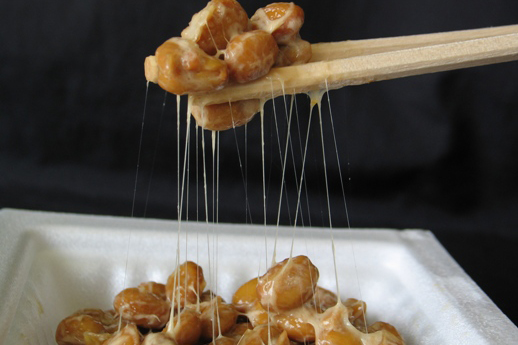Sonya Chung
Two East-Asian countries, d and South Korea, have become “super-aged” societies, as their numbers of seniors (people aged above 65 years) have risen dramatically. According to the UN and WHO, it only took Japan 24 years and will only take South Korea 18 years for their senior populations to double, while it took France 115 years and America 71 years. Triggered by such unbelievable rates, researchers investigated the people’s diet and found that various forms of fermented soybeans are often consumed with rice.
Natto, covered in white mucous sap, is a Japanese traditional fermented soybean product that has a soft texture and an unpleasant wet-sock-like smell (to be extreme); Korea’s cheong-gook-jang is basically the same product with different names. Natto contains high contents of fiber, various vitamins, minerals, and isoflavone (this will be discussed in depth later, don’t worry).
Once soybeans are soaked in water, boiled, and fermented, sensory characteristics of natto are improved, undesirable contents are eliminated, and some nutritional properties are enhanced. The hard and waxy surface of unfermented soybeans become soft in texture and gain a stinky odor. One very unusual property of natto is that, just as these sensory properties change, soy proteins, biological inhibitors, and bacterial enzymes break into easily digestible compounds when fermented. This decomposition allows more nutrients to be absorbed by the body, whereas unfermented soybeans do not grant as much absorption.
Moreover, the fermenting process actually increases the total amount of protein and the absorption of it; findings say that this phenomenon is due to the increase of microorganisms, the synthesis of enzymes, and the rearrangements of pre-existing compositions.
The high levels of vitamin K and isoflavone, specifically, account for natto’s standing as a functional food and dietary supplement. Natto contains hundreds times as much vitamin K, a producer of protein and bones, than other foods; this nutritional richness appoints natto a preventative food for osteoporosis.
Ikeda’s report (2006) on the association of habitual natto intake and bone mineral density (BMD), a means of measuring osteoporosis, depicts the positive relationship between daily natto intake and BMD. The experiment was done with 944 healthy Japanese women of ages 20 to 79, whom were categorized into pre- or post-menopausal; not the focus here, but menopause is when the reproductive hormones decline in female. After years of repeated measurements for the report, it was evident that the more natto consumed, the higher the BMD, meaning stronger bones.
Also an abundant nutrient in natto, isoflavone acts as a blood clot preventer, a blood clot dissolver, and a substitute for female hormone; in addition to reducing DNA damage, it prevents the activities of low-density lipoprotein, also known as the “bad” cholesterol.
Furthermore, isoflavone is accountable for natto’s strong antioxidative activities; but in order to understand what antioxidants are and how they work, the concept of oxidation needs to be covered first (anti-oxidants must be something opposite to oxidants, but just to clarify). Oxidation is the chemical reaction of transferring electrons from a substance to another, and in the process, free radicals are produced; free radicals are molecules that may cause damage or death to cells through chain reactions. Antioxidants, including isoflavone in natto, remove the free radicals and inhibit oxidative reactions. In short, why are antioxidants so important to health? They protect our cells from damage. (Hope you have a clear sense of antioxidants and oxidation now.)
Interestingly enough, according to a study done on Caenorhabditis elagans, a well-used experimental species of worm, the antioxidative effects of natto results in an increase of lifespan. Water extract from natto was injected into C. elagans, and the survival rate under excessive oxidation, a major factor known to reduce human lifespan, increased due to the antioxidative compounds in fermented natto.
Additionally, the average lifespan of the subjects increased by approximately 30% due to the inhibited growth of unfavorable bacteria, and the high polyamine content is further boosted – polyamines are known to have extended the lifespan of yeast, flies, worms, and human immune cells. Such experiments demonstrate that natto exerts high levels of anti-aging materials. (Of course, additional studies are necessary.)
However, because food of such high-nutrition only has a very short shelf-life due to the secretion of ammonia (a hazardous compound) after time, food companies have been continuously attempting to change the form of natto into dry powder. This way, natto will sell as more acceptable and accessible, especially as the unpleasant odor is reduced when dried.
A report on the different drying methods and the nutritional contents of natto concludes that vacuum-drying, freeze-drying, and oven-drying do not affect most of the nutritional content. The results of this experimentation conclude that heating natto at a temperature above roughly 50°C is likely to alter isoflavone into other less-nutritious derivatives and that, despite the drying method, angiotensin-converting-enzyme (ACE) inhibitor activity decreases to about a third of the original level when dried. ACE inhibitor is a drug primarily used to treat hypertension and congestive heart failure.
Yet, (personally speaking) as long as natto is not dried or heated above a high temperature, drying natto is worth more than retaining the original form to keep its ACE inhibitors. ACE inhibitors may be consumed in different methods, but fresh natto may not be as consumed due to its strong odor; odorless dried natto is the alternative for a broader range of consumers.
Even though the direct impact of natto on lengthening one’s lifespan may not be crystal-clear, the overall nutritional content may lead to a healthier diet and body over time.

